|
John C. Breckinridge
United States Vice President and Confederate General
John C. Breckinridge
(January 16, 1821 – May 17, 1875)
| General John C. Breckinridge |
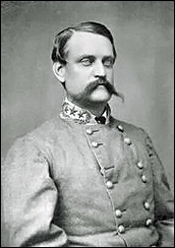
|
| Library of Congress |
At the age of 36, John C. Breckinridge (often misspelled
as Breckenridge) became the youngest Vice President in the history of the United States.
Breckinridge, a U.S. Vice President, the most
senior ranking public official to commit treason, cousin to First Lady Mary Todd Lincoln, presidential candidate (ran against Abraham Lincoln), and prominent Confederate general, has witnessed only
one full-length biography written about him. On the other hand, President Abraham Lincoln has been honored with more than 14,000 biographies.
John Cabell Breckinridge is the only vice president
to take up arms against the government of the United States. He completed four years as the 14th Vice President (1857-1861)
under James Buchanan, ran for president as the Southern Democratic candidate in 1860, and then returned to the Senate to lead
the remnants of the Democratic Party for the first congressional session during the Civil War. Although his cousin Mary Todd Lincoln resided in the White House, and his home state of Kentucky remained a "border state," Breckinridge chose to volunteer
his services to the Confederate army. The United States Senate formally expelled him as a traitor.
(Left) Confederate Maj. Gen. John C. Breckinridge. NPS.
| First Lady Mary Todd Lincoln |
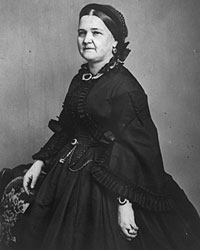
|
| Cousin to Breckinridge |
Commissioned
a brigadier general, and later a major general, Breckinridge went west to fight at Baton Rouge, Port Hudson, Shiloh, Stones River (Murfreesboro), Chickamauga, and Chattanooga.
He returned east to the battle of Cold Harbor, and, in July 1864, he joined General Jubal “old Jube” Early’s Army of the Valley and participated in the
numerous Shenandoah Valley Campaigns and even led a dramatic raid on Washington, D.C. Breckinridge's troops advanced and sacked
Francis Blair's home in retaliation for the burning, by Union
Gen. Hunter, of Governor Letcher's residence at Lexington, Va., one month before. Breckinridge got so close to Washington that he could see the newly completed Capitol dome, and General Early joked that
he would allow him to lead the advance into the city so that he could "sit in the vice-presidential chair again." “We didn’t take Washington,”
Early told his staff officers, “but we scared Abe Lincoln like Hell!”
When General Robert E. Lee surrendered his army, President Jefferson Davis was determined to continue the "fight," but Breckinridge opposed continuing
the war as a guerrilla campaign. "This has been a magnificent epic," he said; "in God's name let it not terminate in farce." Fleeing Richmond, Breckinridge commanded the troops that accompanied Davis and his cabinet. Davis was captured, but Breckinridge evaded arrest and imprisonment by fleeing through Florida
to Cuba. From Cuba
he sailed to England. Subsequently,
the Breckinridge family settled in Toronto, Canada.
His daughter Mary later remarked that, while exile was a quiet relief for her mother, it was hard on her father; he was "separated
from the activities of life, and unable to do anything towards making a support for his family." In Canada, he met other Confederate exiles, including the freed Jefferson Davis. On
one occasion Breckinridge and Davis rode to Niagara.
Across the river they could see the red stripes of the American flag, which Breckinridge viewed nostalgically but the more
embittered Davis described as "the gridiron we have been fried
on."
| 1860 Electoral College Map and the Divided Nation |
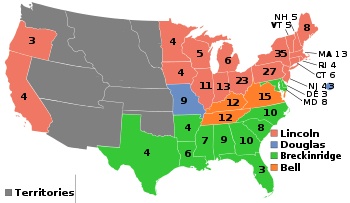
|
| Candidates Lincoln, Breckinridge, Bell, and Douglas |
On
Christmas Day in 1868, departing President Andrew Johnson issued a blanket pardon for all Confederates. John C. Breckinridge returned to the United States
in February 1869. It had been eight long years since Breckinridge had been in Kentucky.
When he arrived in Lexington in March 1869, a band played "Home Sweet Home," "Dixie,"
and "Hail to the Chief." Breckinridge declared himself through with politics: "I no more feel the political excitements that
marked the scenes of my former years than if I were an extinct volcano."
The former vice president practiced law and became active in building
railroads. Although he was only fifty-four, his health deteriorated. Despite his weakened condition, Breckinridge surprised
his doctor with his clear and strong voice. "Why, Doctor," the famous stump speaker smiled from his deathbed, "I can throw
my voice a mile." The gallant and dashing John Cabell Breckinridge died on May 17, 1875.
General
John C. Breckinridge (Confederate)
Compiled
Military Service Record
| John Breckinridge |

|
| General John Breckinridge |
| John C. Breckinridge |
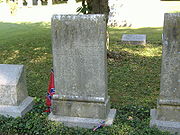
|
| Breckinridge Grave |
Biographical data and notes:
- Born Jan. 16, 1821, in Lexington
-
John Cabell Breckinridge died on May 17, 1875
- Died May 17, 1875, at Lexington, Ky.
Promotions:
-
Promoted to Brig-Gen (Full, Vol) (November 2, 1861)
- Promoted to Major-Gen (Full, Vol) (April 14, 1862)
- Acting Secretary
of War, February 6 to close of war, 1865
Commands:
-U.S.
Army
Breckinridge, John Cabell, major, Third Kentucky Infantry,
in the war with Mexico, 1847.
| John Breckinridge Home |
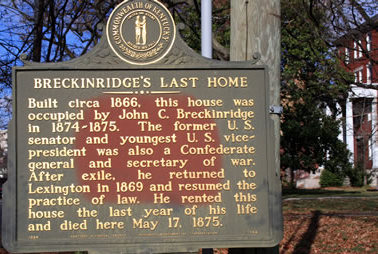
|
| John Breckinridge Memorial |
| John C. Breckinridge Monument |
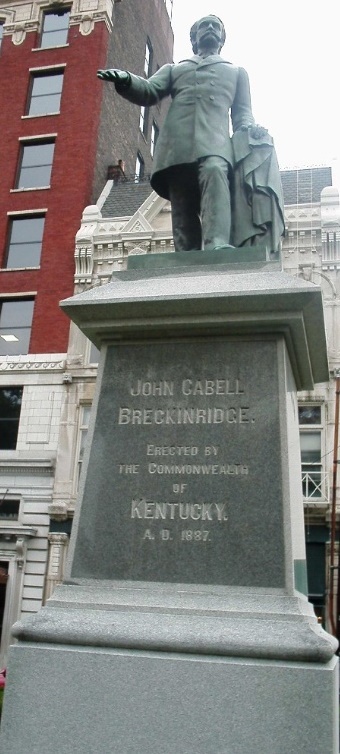
|
| John Breckinridge |
Commands:
-Confederate Army
Commanding First
Brigade of Kentucky Infantry.
Commanding division composed of the brigades of Brigadier
Generals
Daniel W. Adams, Helm and Stovall.
Commanding Reserve Corps, Army of the Mississippi,
April 6
to August 18, 1862.
Commanding, September 8, 1862, division under Major
General Van Dorn.
October 28,
1862. commanding Army of Middle Tennessee.
In December, 1862, commanding division in Polk's Corps,
Army of Tennessee,
composed of the brigades of Hanson, Palmer
and Walker.
Commanding, August 20, 1863, division composed of the
brigades
of Helm, Preston, Brown and Adams.
Commanding, November 8, 1863, to December 15, 1863,
Second
Corps (Hardee's), Army of Tennessee.
Commanding,
September 27, 1864, Department of East
Tennessee and
Trans-Alleghany Department.
Acting Secretary of War, February 6
to close of war, 1865
(Sources listed at bottom of page.)
Highly Recommended Reading: Breckinridge: Statesman, Soldier,
Symbol (Southern Biography Series) (Paperback) (688 pages). Description: William C. Davis has written
the only full-length biography of John C. Breckinridge, who is one of the most fascinating and yet one of the least known
figures in all of American history. Davis begins by charting Breckinridge's early years as a lawyer, his rise in Kentucky state politics and then national politics, his role as Vice-President
and his reluctant campaign for the Presidency in 1860. Davis
then provides an excellent overview of Breckinridge's career as a Confederate military leader, fighting on nearly every front
of the war and ending the war as the Confederate Secretary of State. Continued below...
Davis also gives an outstanding account of Breckinridge's dramatic escape from the country following the
Confederate defeat, which was an adventure so extraordinary that it should be made into a movie. Davis concludes his work by describing
Breckinridge's years as an exile before his final return to Kentucky
and his tragic early death. Davis is one of the nation’s
most respected Civil War historians, and this book is an excellent manifestation of his scholarly and literary gifts. Not
only is it full of information, allowing the reader to truly feel as though they have a solid understanding of Breckinridge's
life, but it is written in such a fine style that it is always entertaining and never dull.
Advance to:
Recommended Reading: Generals in Gray: Lives of the Confederate Commanders. Description:
When Generals in Gray was published in 1959, scholars and critics immediately hailed it as one of the few indispensable books
on the American Civil War. Historian Stanley Horn, for example, wrote, "It is difficult for a reviewer to restrain his enthusiasm
in recommending a monumental book of this high quality and value." Here at last is the paperback edition of Ezra J. Warner’s
magnum opus with its concise, detailed biographical sketches and—in an amazing feat
of research—photographs of all 425 Confederate generals. Continued
below...
The only exhaustive
guide to the South’s command, Generals in Gray belongs on the shelf of anyone interested in the Civil War. RATED 5 STARS!
Recommended Reading: Civil War High Commands (1040 pages) (Hardcover).
Description: Based
on nearly five decades of research, this magisterial work is a biographical register and analysis of the people who most directly
influenced the course of the Civil War, its high commanders. Numbering 3,396, they include the presidents and their cabinet
members, state governors, general officers of the Union and Confederate armies (regular,
provisional, volunteers, and militia), and admirals and commodores of the two navies. Civil War High Commands will
become a cornerstone reference work on these personalities and the meaning of their commands, and on the Civil War itself.
Errors of fact and interpretation concerning the high commanders are legion in the Civil War literature, in reference works
as well as in narrative accounts. Continued
below...
The present
work brings together for the first time in one volume the most reliable facts available, drawn from more than 1,000 sources
and including the most recent research. The biographical entries include complete names, birthplaces, important relatives,
education, vocations, publications, military grades, wartime assignments, wounds, captures, exchanges, paroles, honors, and
place of death and interment. In addition to its main component, the biographies, the volume also includes a number of essays,
tables, and synopses designed to clarify previously obscure matters such as the definition of grades and ranks; the difference
between commissions in regular, provisional, volunteer, and militia services; the chronology of military laws and executive
decisions before, during, and after the war; and the geographical breakdown of command structures. The book is illustrated
with 84 new diagrams of all the insignias used throughout the war and with 129 portraits of the most important high commanders.
Recommended Reading: Lee's Lieutenants: A Study in Command (912 pages). Description: Hailed as one of the greatest Civil War books, this exhaustive study is
an abridgement of the original three-volume version. It is a history of the Army of Northern Virginia from the first
shot fired to the surrender at Appomattox - but what makes this book unique is that it incorporates a series of biographies
of more than 150 Confederate officers. The book discusses in depth all the tradeoffs that were being made politically and
militarily by the South. Continued below...
The book does an excellent job describing the battles, then
at a critical decision point in the battle, the book focuses on an officer - the book stops and tells the biography of that
person, and then goes back to the battle and tells what information the officer had at that point and the decision he made.
At the end of the battle, the officers decisions are critiqued based on what he "could have known and what he should have
known" given his experience, and that is compared with 20/20 hindsight. "It is an incredibly well written book!"
Recommended Reading:
Generals in Bronze: Interviewing the Commanders of the Civil War (Hardcover).
Description: Generals in Bronze: Revealing interviews with the commanders of the Civil War. In the decades that followed the
American Civil War, Artist James E. Kelly (1855-1933) conducted in-depth interviews with over forty Union Generals in an effort
to accurately portray them in their greatest moment of glory. Kelly explained: "I had always felt a great lack of certain
personal details. I made up my mind to ask from living officers every question I would have asked Washington or his generals
had they posed for me, such as: What they considered the principal incidents in their career and particulars about costumes
and surroundings." Continued below…
During one interview session with
Gen. Joshua Lawrence Chamberlain, Kelly asked about the charge at Fort Damnation.
Gen. Chamberlain acquiesced, but then added, "I don't see how you can show this in a picture." "Just tell me the facts," Kelly
responded, "and I'll attend to the picture." And by recording those stirring facts, Kelly left us not only his wonderful art,
but a truly unique picture of the lives of the great figures of the American Civil War. About the Author: William B. Styple
has edited, co-authored, and authored several works on the Civil War. His book: "The Little Bugler" won the Young Readers'
Award from the Civil War Round Table of New York. He is currently writing the biography of Gen. Phil Kearny.
Recommended Reading: Staff Officers in Gray: A Biographical Register
of the Staff Officers in the Army of Northern Virginia (Hardcover) (360 pages) (The University of North Carolina Press)
(September 3, 2008). Description: This indispensable Civil War reference profiles 2,300 staff officers in Robert E. Lee's famous Army of Northern Virginia. A typical entry includes the officer's full name, the date and place of
his birth and death, details of his education and occupation, and a synopsis of his military record. Continued below...
Two appendixes
provide a list of more than 3,000 staff officers who served in other armies of the Confederacy and complete rosters of known
staff officers of each general in the Army of Northern Virginia.
Bibliography: Official Records of the Union and Confederate Armies;
American National Biography; Dictionary of American Biography; Davis, William. John C. Breckinridge: Statesman,
Soldier, Symbol. Baton Rouge: Louisiana State University Press, 1974; Heck, Frank. Proud Kentuckian, John C. Breckinridge,
1821-1875. Lexington: University Press of Kentucky, 1976; Library of Congress; National Park Service; National Archives
and Records Administration; Memoirs of William Williams Stringfield, 1901; Confederate Military History, vol. XI, p. 227;
General Officers of the Confederate States of America; Official Records of the Union and Confederate Armies.
|

